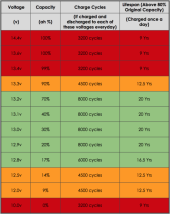Creatura_n
New Member
- Joined
- Sep 26, 2021
- Messages
- 82
Hey guys.
I have a question.
I have a 16s lifepo4 320A with a daly bms 200A 48v
I want to add some more 'juice' to my battery and i want to add in parallel a battery bank of 18650, to be more specificaly a 14s 18650 100A 48v battery bank with his own dalt bms of 120A.
Do you think it will work? Its there any way that it can affect something?
I know that there will be different voltage and the 14s bank wont get 100% charge
I have a question.
I have a 16s lifepo4 320A with a daly bms 200A 48v
I want to add some more 'juice' to my battery and i want to add in parallel a battery bank of 18650, to be more specificaly a 14s 18650 100A 48v battery bank with his own dalt bms of 120A.
Do you think it will work? Its there any way that it can affect something?
I know that there will be different voltage and the 14s bank wont get 100% charge





